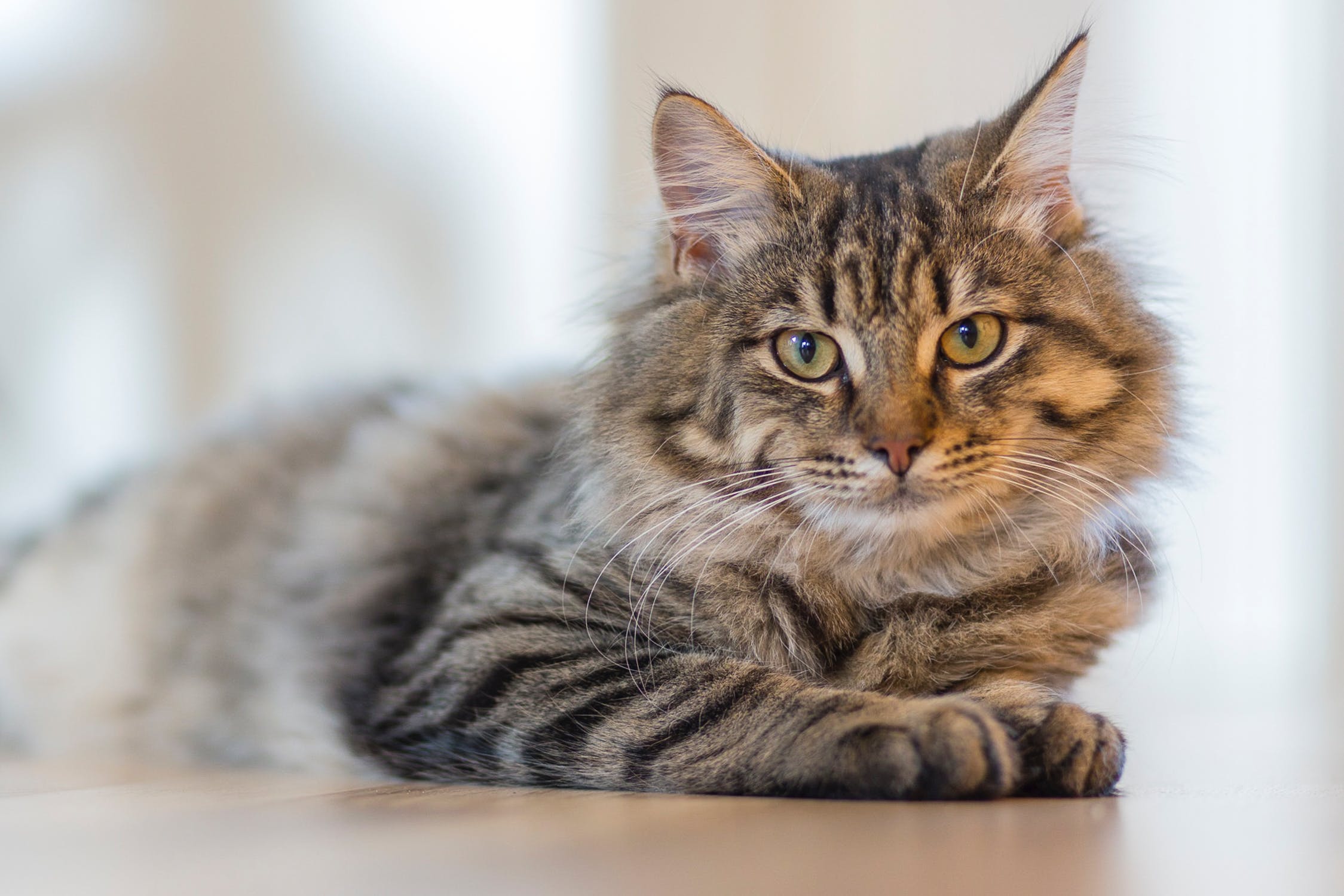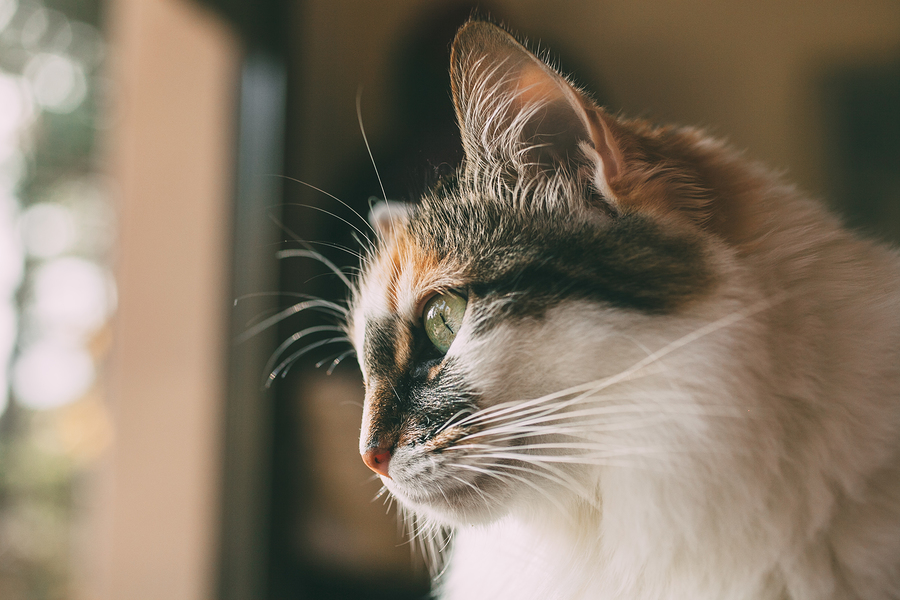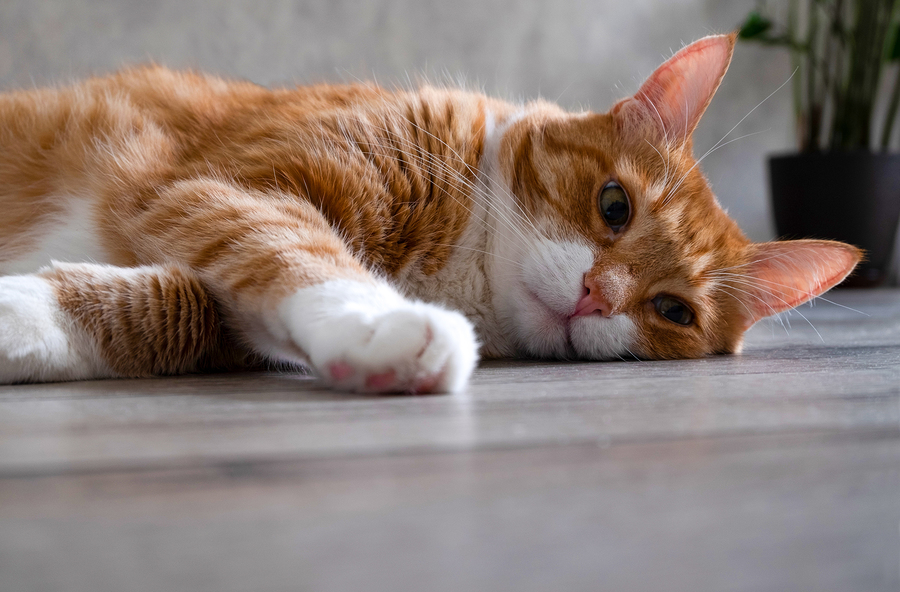
If you’re a cat parent, you know all too well that singular feeling when you’re walking barefoot through the house and your foot comes to rest on something small, soft, squishy, and wet. You instantly know what’s happened.
You stepped on a hairball.
I’m constantly on the lookout for these little landmines, but sometimes I make barefoot contact with one, usually at night when making final rounds before bed and all the lights are turned off.
In fact, as I just went upstairs to refill my coffee, I found a fresh one sitting outside my home office door.
Yes, hairballs are a fact of life when you live with one or more kitties. But hairballs may occur more frequently in some cats than others, and can even be a sign of serious disease in rare cases.
In this article, we’re going to discuss what a hairball is, why they happen, some hairball remedies to reduce the number of squelchy surprises your foot finds, and when to know if they are part of a serious condition. Also, do cats really “cough up” hairballs? We’ll talk about this too.
What’s a Hairball?
Using a little tongue in cheek humor, a hairball is that gross squishy thing your cat left behind, that you just stepped in.
But in all seriousness, a hairball (or “trichobezoar” as veterinarians may technically refer to it) is a small collection of cat fur, that for some reason hasn’t passed out of the stomach to the intestinal tract, and ends up being vomited up, usually in a cylindrical or cigar-like shape.
That’s right, hairballs are vomited up, not “coughed” up. But we’ll address that point in a little bit.
Why Do Cats Get Hairballs?
Cats are very fastidious groomers, as all cat parents know. Cats groom themselves multiple times a day, and this is actually a very healthy and necessary behavior. Grooming removes dead fur, helps to exfoliate the skin, and redistributes protective oils.
A cat’s tongue is even designed just for this purpose. Remember the last time your kitty licked your hand? How rough it felt, kind of like sandpaper? A cat’s tongue has tiny little projections called papillae that look kind of like backwards facing spiny hooks. They’re made of keratin, the same substance our fingernails are made of.
Grooming is also not just a singular behavior for cats, but a social behavior as well. If one cat grooms another cat, there is trust between them, at least for that moment. So if your cat starts to lick your hand or arm, this is a significant sign of bonding between you. So, although it feels weird, try to let it happen. I just wouldn’t recommend returning the favor.
While grooming behavior in cats is natural and very important, it does have one negative effect. Cats wind up ingesting all of the dead hair they groom off of themselves or one another.
Hair is not digestible, so it needs to find its way out one way or another. A lot of this hair passes out of the stomach, along with food, travels through the digestive tract, and eventually gets pooped out.
But some hair will sit lining the walls of the stomach and collect over time, eventually amassing at the outflow tract of the stomach, called the pylorus, which is kind of like the gateway to the small intestine.
If the wad of hair can’t really make its way through, or if there’s enough of it to cause irritation of the stomach lining, a vomiting episode will occur. And because the wad of hair must come back up through the esophagus, when it’s expelled it will take on that characteristic cylindrical or cigar-shaped appearance.
Some cat caretakers may confuse a hairball with feces. I’ve had the occasional client insist their kitty is pooping throughout the house, but when they bring in a sample, it’s clearly a hairball. It’s true that both items are kind of gross, but if you want to tell the difference, it’s pretty easy, if you’re brave enough to get up close.
Using a paper towel, pick up the offending item. A hairball will have little to no odor, and will either resemble the same color as a cat’s hair coat, or may have a green or yellow tinge to it. Pulling at a hairball will make it clear that the item is composed of hair, because you’ll see the individual strands. If it’s feces, you won’t have to touch or pick at it, and I would advise you not too. A quick whiff will tell you it came from the other end.
Hairballs are also often accompanied by a similar amount of green or yellow fluid. This fluid is called bile, which is produced by the liver and stored in the gallbladder. Bile is released from the gallbladder into the small intestine, where it helps with digestion.
When any living thing vomits, some of that bile from the small intestine will make its way up into the stomach to be expelled with stomach contents. This most often happens on an empty stomach, or when only something very small is being expelled, like a hairball.
Do Cats “Cough Up” Hairballs?
It’s a fair question because there are many social misconceptions about cats, including that they can persist on milk (most adult cats are lactose intolerant), fish (a pure raw fish diet will cause a B vitamin deficiency), and that they “cough up” hairballs.
Some folks are under the impression that a cat with a hairball will have a coughing fit, even though no hairball is being produced. Perhaps the assumption is that she swallows it.
But what this is actually describing is a more potentially concerning condition. If a cat kind of hunkers down close to the floor, extends his neck, and proceeds to cough or hack, especially with his tongue extended, this is actual coughing, and is not associated with hairballs.
This is actually the classic presentation of a cat with an asthmatic cough. Feline asthma is an allergic respiratory disease that affects many cats and can be fairly mild or very severe.
My own cats will exhibit a cough like this perhaps once or twice a month. But some cats exhibit these signs on a weekly or even daily basis, and the signs can escalate, with some kitties being rushed to the hospital for acute respiratory distress.
In contrast, a cat bringing up a hairball will show signs of vomiting. Usually, they’re actually sitting up far more, and have a bit of a sudden, distressed look. Vomiting is always accompanied by abdominal contractions, so often, it’ll look like a kitty’s belly is having spasms. Some cats who vomit will vocalize or yowl, while others may make some odd gurgling-type noises.
But at the end of this spectacle, something always comes up, like your characteristic cylindrical wad of hair, along with some bile.
If you’re having trouble telling the difference, check out this link for Fritz the Brave, which is a site dedicated to asthmatic cats and education about the condition. There is a video link which shows the characteristic asthmatic cough, which is so often confused with a cat having hairballs.

When Hairballs are Normal (And When They’re Not)
By and large, hairballs are a normal part of a cat’s existence. But deciding just how normal for your own cat depends on frequency. A normal cat shouldn’t really have hairballs more than a couple times a month. This might be a little more frequent for a long-haired kitty or for multiple-cat households where there is lots of co-grooming going on.
Also remember that cats can be seasonal shedders, just like dogs. This is especially true for our long-haired cats. The most common and prolific shedding time is spring, when the thicker winter coat is being shed.
But fall is also another time, because the shorter summer coat needs to be shed to make room for the thicker winter coat to grow in. During these times, you may notice an uptick in hairballs as your kitty removes more dead hair with grooming. These are more important times to help your kitty out with some treatments we’ll discuss just a little bit later.
So if your kitty has a couple hairballs a month and maybe some increases with shedding seasons, not to fear. But if you’re seeing more frequent hairballs, like a couple of times every week, this may be a sign for a more concerning problem.
You have to remember again, that hairballs are vomited. So if we’re seeing multiple hairballs every week, this really translates into multiple vomiting episodes every week.
If on top of just hairballs, we’re also seeing food coming up as well, even just after your kitty “eats too fast”, this really should be considered to be more of a vomiting disorder.
There are several disorders that can cause vomiting in cats. We won’t discuss all of them in great detail, but it’s important to understand some of the categories. Many of these also come with weight loss, which you won’t see with basic hairballs.
There are some conditions called metabolic conditions, which are associated with organ function, that can cause vomiting and weight loss. These includes kidney and liver disease.
Endocrine conditions include diabetes and hyperthyroidism. Diabetes, similar to Type II in people, is far more common in overweight cats exceeding 11 or 12 pounds in weight. In cats that go untreated for long enough or who are poorly regulated, a condition called diabetic ketoacidosis can develop, which is very serious, where vomiting is often seen. Hyperthyroidism is caused by overactive thyroid glands, and causes weight loss most commonly, though digestive upset can be seen in some cases that are poorly controlled.
Inflammatory bowel disease is a common disorder among cats, especially middle-aged to older kitties, that leads to a variety of gastrointestinal signs, including vomiting, diarrhea, and weight loss.
Diagnosing this condition can be suspected based on how often we’re seeing vomiting episodes occur. This suspicion is heightened if our basic bloodwork is normal, ruling out your metabolic and endocrine diseases, and especially if we’re seeing concurrent weight loss.
There are a few ways to arrive at a diagnosis of inflammatory bowel disease, as well as empirical therapy measures, which can all be discussed further with your veterinarian.
Sometimes, the first place to start is changing to a very strict prescription diet with a novel, or uncommon protein source, like rabbit.
More severe cases of inflammatory bowel disease may not respond well to a diet change, and in some cases, may instead be a type of cancer called lymphoma. In either case, more aggressive medical therapy is required.
Lastly, always remember that cats eat stuff that they really shouldn’t. Plastic, string, hair bands, houseplants, even dried dead leaves. So if your kitty doesn’t have a history of chronic vomiting or just has hairballs a couple times a month, but then suddenly starts vomiting multiple times, don’t assume she just has a really tough hairball to get out.
Cats that ingest lots of hair through grooming are also at risk of getting constipated or even having an intestinal obstruction from the amount of hair they consume. Sometimes, when this occurs, we can see vomiting, just like with a blockage from any other foreign substance a kitty might eat.
In general, be more concerned that any acute change in vomiting could be the sign of a medical problem that your vet needs to evaluate.

Home Hairball Remedies
Having discussed some more serious and scary causes of vomiting, let’s remember that most cats with occasional hairballs don’t have these conditions if all else is normal.
But that doesn’t mean that we can’t help them out, especially in situations where hairball frequency may be greater, like during shedding seasons, or in environments where multiple cats are grooming each other.
Following are some remedies that can reduce hairball frequency by improving passage of hair through the digestive tract.
Oral Laxative Gel
Oral laxative gels are by far the most common household remedy for hairballs. A laxative is essentially a substance that helps to loosen or lubricate digestive contents so that everything can get pooped out more easily.
Cats ingesting lots of hair through grooming are prone not just to more hairballs, but also to constipation from wads of hair getting caught in the intestines, which is another reason that laxative gels can be helpful for more mildly affected kitties.
Common ingredients for laxative gels include petrolatum, mineral oil, soybean and fish oils, and molasses.
For the more natural route and petrolatum-free formulations, beeswax is another common ingredient, as found in Hairball Aid Gel.
These types of products are appropriate to give daily to kitties at higher risk from more frequent hairballs, or they can also be used more often only during those peak shedding times.
Most of the time, these gels are tasty enough that cats will lick the recommended amount, typically about ¼ of an inch long strip of gel, off your finger. But for cats who are really picky about treats, these gels provide the opportunity for a fun trick for administration that plays against the fastidious nature of all kitties.
If your cat won’t take the gel willingly, smear the recommended amount on her paw. Your cat’s need to groom anything foreign off of herself will make sure she licks all of the gel from her foot. It’s a great trick that really works in most cases.
Osmotic Laxatives
For cats that have more chronic issues with constipation due to hair ingestion, the osmotic laxative Miralax is a common one we employ. The active ingredient is polyethylene glycol 3350, which works with the body to draw water where it needs to go.
For example, if you have some dry, constipated stool matted with cat hair, PEG 3350 will pull water into the colon to help lubricate and loosen that stool and allow it to pass. In some cases, it can also help with diarrhea by leading to the opposite action by pulling water out of the colon.
The most common starting dose is ⅛ to ¼ teaspoon once a day and adjusting amount and frequency from there. Being a powder, the best way to administer it is to mix it with some canned or soft food.
Make special note that polyethylene glycol 3350 is NOT the same thing as ethylene glycol, the active ingredient in antifreeze, which is toxic to pets. Though the name may be similar, the chemical composition of these items is very different.
PEG 3350 is very safe to use, though you want to make sure to increase or decrease amounts in very small increments to avoid too much of a good thing and getting loose stool or diarrhea. Seek advice from your kitty’s vet to help determine the best regimen and adjustments.
Dietary Fiber
There are two main classes of dietary fiber, soluble and insoluble. Soluble fiber is found more in pectins and gums, like fruits. Soluble fiber dissolves in water and creates a kind of gel that can have many health benefits for digestion by slowing down intestinal transit time. This can help improve digestion of nutrients, help with weight management, and keep blood sugar levels and cholesterol more stable.
But though these are great things for general health, they don’t help us as much when we’re trying to get more water into the colon and increase intestinal transit time to move everything along.
For this, we want more insoluble fiber. Insoluble fiber contains cellulose and hemicellulose that comes from woodier plants, vegetables, and whole grains. It draws water into the colon, which lubricates stool. And since insoluble fiber doesn’t absorb that water and can’t be digested, it gets pushed along more quickly, moving everything else with it.
Many natural fiber sources contain a bit of both types of fiber. Canned pumpkin is a great example, and psyllium husk is another. What about adding canned pumpkin for your cat? It’s generally okay to add small amounts, like a ½ tablespoon to each meal, and in fact you’d probably have trouble adding more.
The only problem with pumpkin as a fiber source, is that as a mix of both types of fiber, you may not really be getting that desired effect of insoluble fiber that you want. Results with canned pumpkin are also extremely variable in pets.
For at-risk cats, the best way we can consistently employ dietary fiber is through a prescription diet that’s specifically formulated with the right percentages of insoluble to soluble fiber. There are a couple different ones, and your veterinarian can review the choices with you.
For more information on why prescription diets provide the best results and why adding sources like canned pumpkin can be kind of hit or miss, check out this short article from the Clinical Nutrition Service at the Tufts University Cummings Veterinary Medical Center. https://vetnutrition.tufts.edu/2017/09/the-problem-with-pumpkin/
Having a Ball with Hair
Living with cats generally means living with hairballs. I haven’t worked with a kitty yet that didn’t have at least occasional ones.
But the most important thing in summary is to recognize when they’re too frequent, when we’re seeing other complications, or when hairballs aren’t the problem at all, as with coughing from feline asthma.
So for most of us, arm yourself with a hairball remedy gel for as-needed use, watch where you step, and invest in a pet-friendly carpet-cleaner.
And if you have further questions or just aren’t sure if your cat is “just having hairballs” or if something more serious may be going on, make sure to have your kitty examined by your vet so you can have a more in-depth discussion about possibilities and therapy options.
About Us
We've taken the guesswork out of caring for your pets. Our formulations are created by experienced veterinarians to address specific solutions for a variety of pet issues.
All of our products are:
As seen on:











